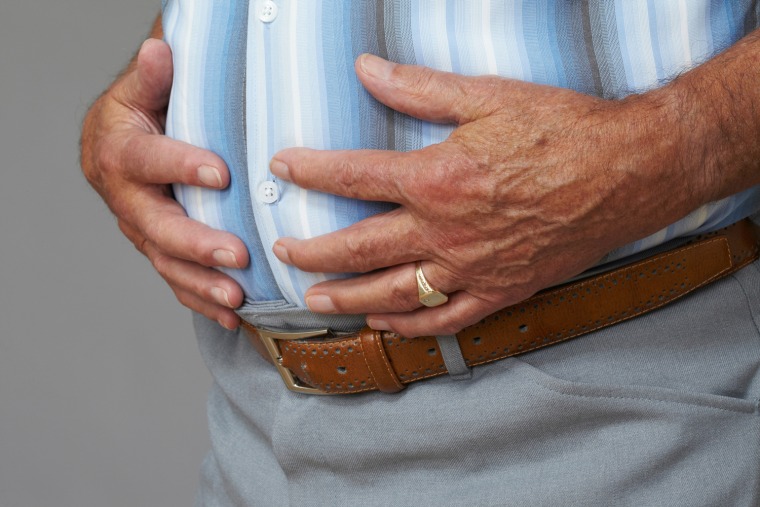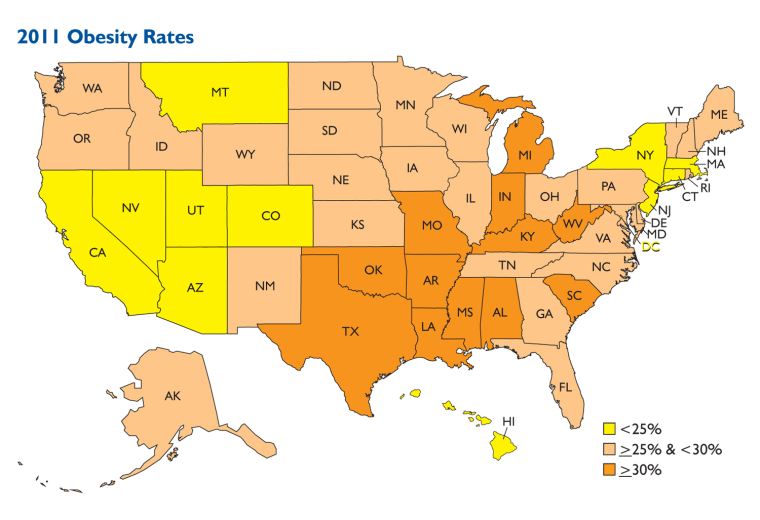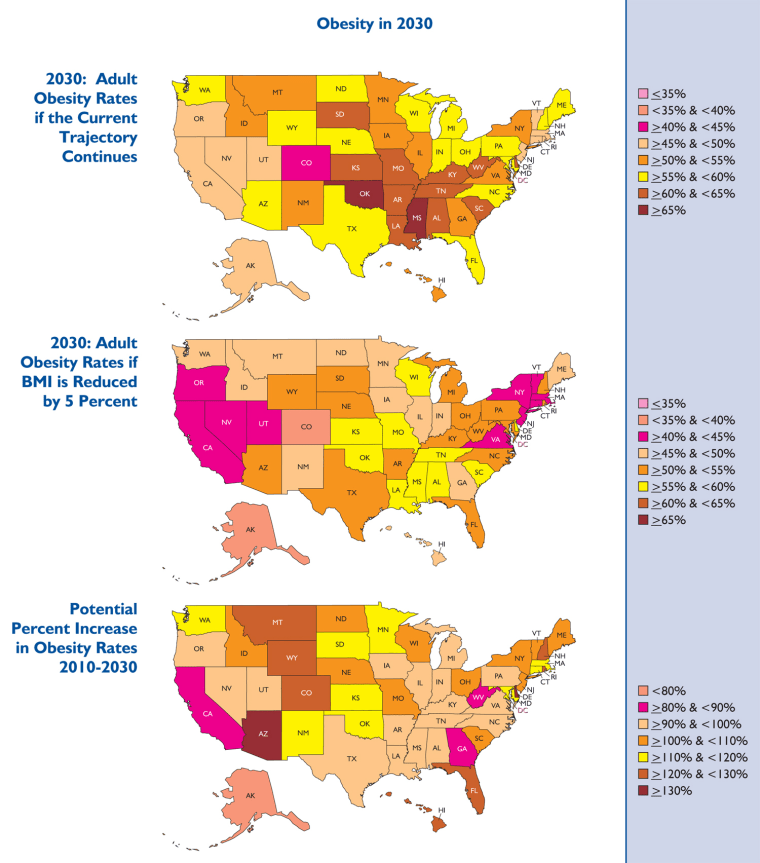
Think Americans are fat now? After all, a third of us are overweight and another 35 percent are obese. But a report out Tuesday projects 44 percent of Americans will be obese by 2030.
In the 13 worst states, 60 percent of the residents will be obese in less than two decades if current trends continue, the report from the Trust for America’s Health projects. That’s not chubby or a little plump – that’s clinically obese, bringing a higher risk of heart attacks, strokes, diabetes, several forms of cancer and arthritis.
“The initial reaction is to say, ‘Oh it couldn’t be that bad’,” says Jeff Levi, executive director of the Trust for America’s Health. “But we have maps from 1991 and you see almost all the states below 10 percent.” By 2011 every single state was above 20 percent obesity, as measured by body mass index (BMI), the accepted medical way to calculate obesity. Those with a BMI or 30 or above are considered obese.
In August, the Centers for Disease Control and Prevention reported that 12 states have an adult obesity rate over 30 percent. Mississippi had the highest rate of obesity at 34.9 percent. On the low end, 20.7 percent of Colorado residents are obese. CDC projections for obesity resemble those in Tuesday's report - it projects 42 percent of adults will be obese by 2030.
The problem isn’t just cosmetic. “The number of new cases of type 2 diabetes, coronary heart disease and stroke, hypertension and arthritis could increase 10 times between 2010 and 2020 — and then double again by 2030,” the report projects. “Obesity-related health care costs could increase by more than 10 percent in 43 states and by more than 20 percent in nine states.”
That’s bad news when states are already strapped to pay for public health programs such as Medicaid and the federal government is struggling to fund Medicare.
Over the next 20 years, more than 6 million patients will be able to blame obesity for their diabetes, 5 million will be diagnosed with heart disease and 400,000 will get cancer caused by obesity.
And some of them are frighteningly young.
"Now I am seeing 25-year-olds weighing 350 pounds who present with chest pain or shortness of breath," says Dr. Sheldon Litwin, a cardiologist at Georgia Health Sciences University. “Everything from the heart disease process to its diagnosis and treatment are affected by obesity. We see it every day. This really is the number-one issue facing us," added Litwin, who worked on one of a series of obesity studies published in this week’s issue of the Journal of the American Medical Association.
The trend is not inevitable, according to the report, entitled “F as in Fat.” Some programs are beginning to make a dent in the rising rates. “We certainly see, in some communities, the beginning of some changes,” says Levi. “We know what some of the answers are.”
Convicted killer: I'm too obese to be executed
For instance, making it easier for people to exercise day in and day out, and making it easier to get healthy food. “A large-scale study of New York City adults found that increasing the density of healthy food outlets, such as supermarkets, fruit and vegetable markets, and natural food stores is associated with lower BMIs and lower prevalence of obesity," the report reads.
What about initiatives like New York’s controversial ban on the largest sodas? “Every community is going to experiment with different approaches. It is going to be very interesting to see what happens in New York and whether this makes a difference,” Levi said.
New York’s health commissioner, Dr. Thomas Farley, defends the move in the medical journal’s obesity issue. "How should government address the health problems caused by this successful marketing of food? To do nothing is to invite even higher rates of obesity, diabetes, and related mortality,” he wrote.

Many studies have also shown that people who live in big, walkable cities such as New York and Washington D.C. are thinner than their rural and suburban counterparts, and it’s almost certainly because they walk more and use public transportation instead of sitting in cars.
If everyone lost just a little weight, the savings would be enormous, the study predicts.
“If we could lower obesity trends by reducing body mass indices (BMIs) by only 5 percent in each state, we could spare millions of Americans from serious health problems and save billions of dollars in health spending —between 6.5 percent and 7.8 percent in costs in almost every state,” the report says.
Education can’t hurt, either. The more educated people are, the less likely they are to be obese. Higher-earners are also thinner. “More than 33 percent of adults who earn less than $15,000 per year were obese, compared with 24.6 percent of those who earned at least $50,000 per year,” the report notes. And several studies have shown that people who eat more fruits and vegetables are thinner, as well as healthier. “Seven of the 10 states with the highest rates of obesity were also in the bottom 10 for fruit and vegetable consumption,” the report says.
Levi believes it’s worthwhile targeting kids the hardest. New nutritional guidelines for schools will help, he said, as will initiatives to restore recess and physical education classes. Beverage makers have agreed to replace sugary sodas in vending machines with water and other low-calorie drinks. “It is as simple as an hour a day less of screen time and one less sugar beverage,” Levi says. “Just 120 calories can make a big difference as to whether a kid crosses over from being normal weight into overweight and obesity.”
Another study in the Journal of the American Medical Association showed that kids who exercised 20 minutes a day lowered an important measure of diabetes risk by 18 percent. Exercising 40 minutes a day cut the risk by 22 percent. The researchers also noted it’s important to make exercise fun for kids
"Regulation sports tend to have kids standing around a lot waiting for the ball. We had enough balls so everyone was moving all the time," said Dr. Catherine Davis of Georgia Health Sciences University. "It had to be fun or they would not keep coming.”
For some people, drastic measures remain an option. One study in the Journal shows that gastric bypass surgery is a viable option. And two doctors present opposing views over whether the Food and Drug Administration holds obesity drugs to an unreasonably high standard. On Tuesday, one of the newest obesity drugs hits the market - Qsymia, made by Vivus.
Are you obese? The National Institutes of Health has a BMI calculator here. http://www.nhlbisupport.com/bmi/
If you’re 5 feet 6 inches tall, you become overweight at 160 pounds (a BMI of 25.1) and obese at 192 pounds, when your BMI grows to 30.1.

Related stories:
How to purge that pudge after menopause